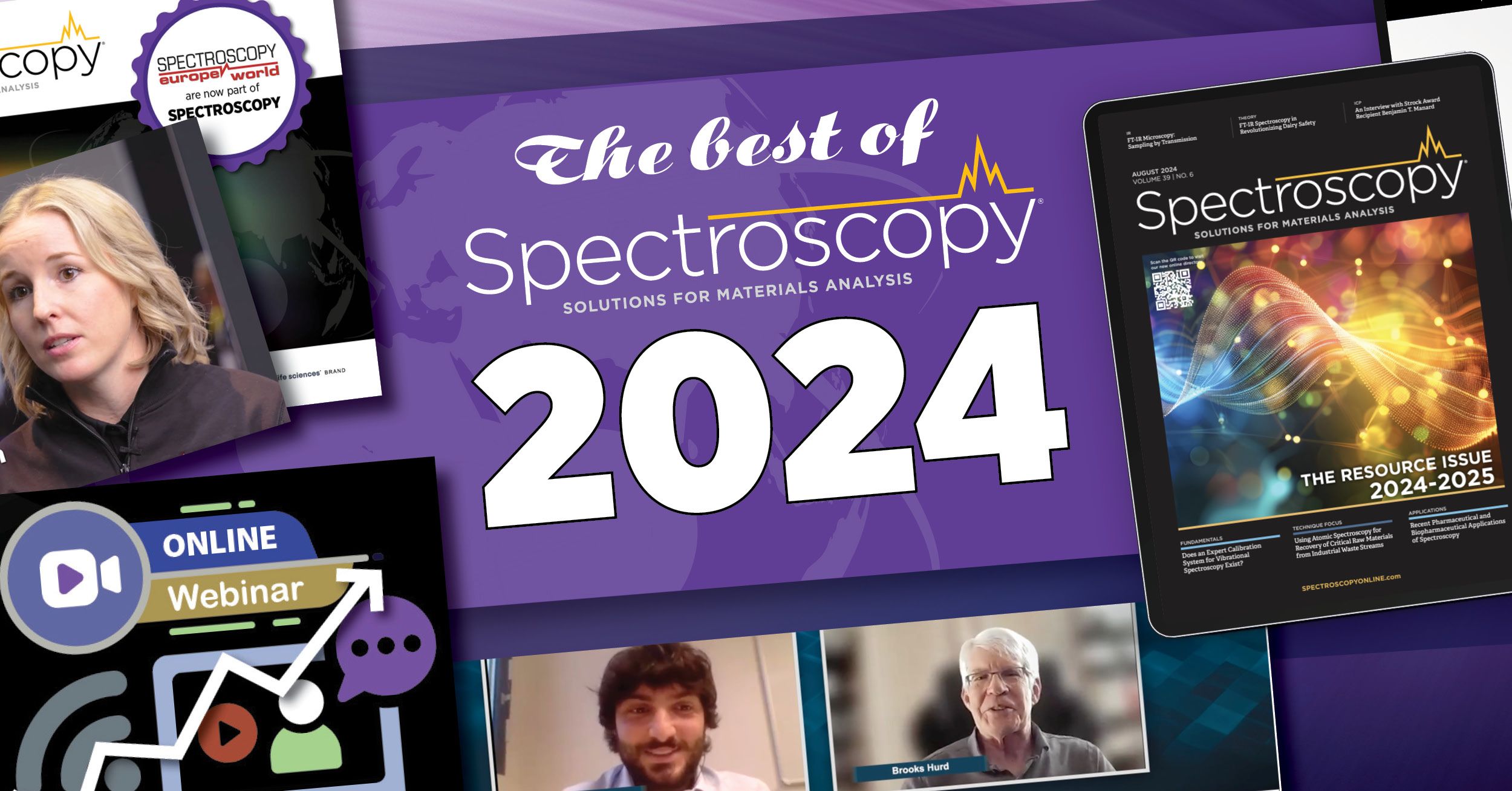ICP-MS Highlights: A Spectroscopy Year in Review
Reflecting on 2024, the editors of Spectroscopy highlight some of the most notable articles and online content on inductively coupled plasma mass spectrometry (ICP-MS) and inductively coupled-optical emission spectroscopy (ICP-OES).

Inductively coupled plasma mass spectrometry (ICP-MS) is an analytical technique that measures and identifies the elements in a sample. ICP-MS is used in many fields, such as environmental, food, medical, life science, materials science, and manufacturing. For example, some studies have used the technique to monitor water quality, measure strontium isotope ratios in wine and grains, and detect toxic elements in food. During ICP-MS analysis, a sample is introduced into an argon plasma that ionizes the sample's atoms. A mass spectrometer then separates the ions by their mass-to-charge ratio, and a detector counts the number of ions to determine the concentration of each element.
ICP-MS offers analytical scientists many benefits. The technique is highly sensitive, with low detection limits, and can analyze both main components and trace elements simultaneously. In addition, ICP-MS can be automated, which increases accuracy, precision, and throughput.
Spectroscopy has published many peer-reviewed, featured articles, and interviews, highlighting the use of ICP-MS and inductively coupled plasma optical emission spectroscopy (ICP-OES) in a variety of applications. The following are just a few of our most popular and thought-provoking pieces, along with links for easy access. We invite you to visit our ICP-MS topic page to search for other articles on this technique, as well as other spectroscopy-related subjects.
Advances in ICP-OES and ICP-MS for Today’s Spectroscopists
Inductively coupled plasma–optical emission spectroscopy (ICP-OES)andinductively coupled plasma–mass spectrometry (ICP-MS) are spectroscopic techniques usedforelemental analysis.ICP-OESdetects the light emitted by atoms excitedina plasma, making it idealformulti-element analysis with high throughput.ICP-MSdetects ions based on their mass-to-charge ratio, allowingfor trace-level elemental analysisandisotope ratio determination. These techniques are widely appliedinenvironmental monitoring, such as assessing heavy metalsinwater, soil,andair, as well asinthe pharmaceuticalindustryforensuring compliance with elemental impurity regulations.Inour “AdvancesinICP-OESandICP-MSforToday’sSpectroscopists,”Spectroscopyspotlights howICP-OESandICP-MSare being usedinseveral keyindustries.
Analysis of Organometallic Compounds and Metallic Particles in Specialty Gases by Direct Injection Using Gas Exchange Device (GED) Coupled to Inductively Coupled Plasma–Mass Spectrometry (ICP-MS)
An article by scientists at PerkinElmer introduced the concept of a gas exchange device (GED) and how it can be used to monitor organometallic compounds and metallic particles in specialty gases. The GED–inductively coupled plasma–mass spectrometry (GED–ICP-MS) workflow eliminates the need for any offline sample preparation, making it the ideal tool for online metallic impurities monitoring. The authors believe that this technology can be deployed to monitor specialty gas impurities in process chemicals at delivery, distribution points, and point of use.
Simultaneous Determination of 50 Elements in Geological Samples by ICP-MS Combined with ICP-OES
In this peer-reviewed paper, a method combining ICP-MS with ICP-OES was developed for multielement determination of 50 species of major, minor, micro, and trace, rare earth, and rare elements in geological samples.
The Importance of Routine Maintenance in ICP-MS
Robert Thomas, Spectroscopy’s “Atomic Perspectives” column editor and author of the recently published Practical Guide to ICP-MS and Other AS Techniques: A Tutorial for Beginners, presented an excerpt of his book focused on the importance of routine maintenance in ICP-MS.
Applying ICP-MS and ICP-OES in Industrial Waste Streams
In these editions of “Atomic Perspectives,” Glenna Thomas presented a two-part article on the application of atomic spectroscopy techniques, including ICP-MS and ICP-OES, in the recovery of critical raw materials from industrial waste streams.
An Interview with Frank Vanhaecke, the 2023 Royal Society of Chemistry Theophilus Redwood Prize
Frank Vanhaecke of Belgium’s Ghent University, and the recipient of the 2023 Royal Society of Chemistry Theophilus Redwood Prize for outstanding contributions to the chemical sciences in analytical chemistry, conducted a plenary lecture, as well as chaired a symposium, at this year’s SciX conference in Raleigh, North Carolina. One of Vanhaecke’s most recently developed a novel method allowing for direct isotopic analysis of mercury (Hg) in solid samples without any prior sample treatment. The method was achieved by modifying a commercially available Hg combustion analyzer based on the trapping of Hg vapor on a gold amalgamator and detection using cold vapor atomic absorption spectroscopy (CVAAS) for enabling its coupling to a multi-collector inductively coupled plasma-mass spectrometry (MC-ICP-MS) instrument. Spectroscopy conducted a pair of interviews with Vanhaecke in 2024.
Benjamin T. Manard of the Chemical Sciences Division at Oak Ridge National Laboratory (Oak Ridge, Tennessee) received this year’s Lester W. Strock Award, given by the New England Section of the Society for Applied Spectroscopy in recognition of a selected publication of substantive research or application of analytical atomic spectrochemistry in the fields of earth science, life sciences, or stellar and cosmic sciences. Manard spoke to Spectroscopy about an analytical procedure, single particle-inductively coupled plasma-time-of-flight-mass spectrometry (SP-ICP-TOF-MS), being utilized to determine the platinum-binding efficiency of protein-coated magnetic microparticles.
Smarter Sensors, Cleaner Earth Using AI and IoT for Pollution Monitoring
April 22nd 2025A global research team has detailed how smart sensors, artificial intelligence (AI), machine learning, and Internet of Things (IoT) technologies are transforming the detection and management of environmental pollutants. Their comprehensive review highlights how spectroscopy and sensor networks are now key tools in real-time pollution tracking.